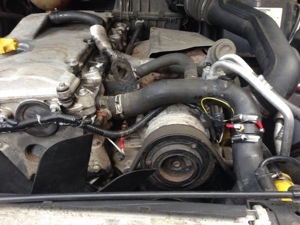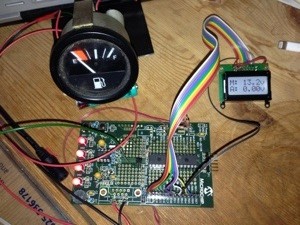 The fuel and battery monitoring system is now ready for the next stage, transferring the design from a prototyping board to a custom board design. The new 2×8 character display seems to be clear enough and is small enough to mount in the dashboard somewhere. I’ll add/maintain support for in situ programming of the PIC chip so I can tweak the calibration and display functions as required.
The fuel and battery monitoring system is now ready for the next stage, transferring the design from a prototyping board to a custom board design. The new 2×8 character display seems to be clear enough and is small enough to mount in the dashboard somewhere. I’ll add/maintain support for in situ programming of the PIC chip so I can tweak the calibration and display functions as required.
Hopefully I’ll get the PCB Design finished and the board etched this evening.
The module itself has suffered from a bit of bloat ware during the design process but hopefully it’s now got all the hardware features it needs to support and anything beyond that can be tweaked in the software. Once it’s all finalised I’ll create a page with the design for anyone that wants something similar.
Author Archives: Dave
Engine monitoring system
I started to fit the sensors for the EMS today. The engine monitoring system I’ve chosen is a South African design and it should give us an early warning of any problems developing with the engine.
The EMS will monitor and display:
- Coolant temperature
- Coolant Level
- Exhaust Gas Temperature
- Oil Pressure
- Battery voltage
- Transfer box temperature
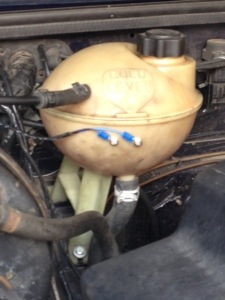 The gauge itself replaces the standard temperature gauge and allows alarm levels to be set for any of the items it is monitoring with both a visual and audible alarm.
The gauge itself replaces the standard temperature gauge and allows alarm levels to be set for any of the items it is monitoring with both a visual and audible alarm.
As I had to drain the coolant to fit the coolant temp sender I also replaced the thermostat – one of those jobs that’s been on the “to do” list for a while now.
The oil pressure sender was the only one that caused me some grief. Partly this was because the kit seemed to have the wrong adaptor with it. I had a suitable adaptor in the garage so I managed to get around that particular problem. The bracket that the sender comes with though is a bit small for it’s intended use and that, combined with limited space between the cylinder head and the air filter box made the job a real PITA.
Anyway, the sensors are in and the wiring made up to the bulkhead so just the gauge to fit and the wires to join up and it’s just about done.
Fuel revisited, again !
Having had some time to go over our experiences of the last week or so it seems that yet more “tweaks” will need to be made to the fuel system although, thankfully, nothing too painful.
The good news was that with the 90 fully loaded in “overland” mode the new MAF sensor I fitted just before we left has brought the fuel consumption back into the realms of “reasonable”. With a mix of motorway, dual carriageway, narrow B roads and some town driving we were getting just above 24MPG during the trip. Having the twin tanks really let us push the limits on range without having to worry about running out of fuel. The main tank gave us a range of just over 430 miles without running out – I’d have let it run out just to see how far we could have got on it but we were on the motorway at the time and I didn’t fancy having the engine stop in that environment. We haven’t taken the front tank more than 200 miles yet but it’s looking as if the combined range is going to be in the region of 750 miles.
The only problem we’ve encountered is that the fuel gauge isn’t directly connected to the sender on the TD5, instead it’s controlled by the Speedo… really, it is ! The speedo prevents large changes in the gauge reading which probably serves to stabilise it off road. The problem is that when you change tanks, if the fuel levels are very different, the gauge takes 30 mins to adjust unless you turn the ignition off and back on again.
As a result I’ve been pondering on a way to resolve this and also to give a more believable fuel gauge reading for the current selected tank. The battery/fuel monitor will now drive the dashboard fuel gauge directly, bypassing the normal speedo circuit. The monitor will be connected directly to the two fuel tank senders and I can then calibrate the sender for each tank in the firmware. It will also light up the dashboard “low fuel” warning light (another job the speedo does at the moment). I got the gauge driver hardware/software working today, I just need to change the display to a smaller 2 rows x 8 characters display to make it easier to mount it somewhere in the dash.
An early bath
 After a couple of restful nights in the New Forest and a couple of hours looking at short and long range forecasts we took the decision to cut our losses and head for home. If the forecasts were to prove anything close to true than we wouldn’t get a chance to test out most of the things we wanted to test out anyway and we could get more done at home where the forecast was much better.
After a couple of restful nights in the New Forest and a couple of hours looking at short and long range forecasts we took the decision to cut our losses and head for home. If the forecasts were to prove anything close to true than we wouldn’t get a chance to test out most of the things we wanted to test out anyway and we could get more done at home where the forecast was much better.
On the way home we made a slight diversion to another of our favourite places from our regular trips to the New Forest 20 years ago, the Hawk Conservancy. We could only stay for the morning display as we wanted to get home in reasonable time. It’s changed a huge amount since our last visit, in fact we could barely recognise the place. It was strangely reassuring to know that at least one of the birds of prey (Frodo, the Tawny Eagle) is still part of the display. It gave me an opportunity to test our compact camera out on some “wildlife” though – we’ve decided not to take the SLR with us to Australia, too bulky and too heavy !
 The results from the small Sony compact “super zoom” were pretty impressive really although the lack of a view finder is probably going to leave us looking for an alternative. in strong sunlight it’s impossible to see the display making taking any photo a bit of a guessing game. I’d noticed this previously but it really became obvious when trying to frame shots of the birds of prey with the sun behind you. The shot I got of the Bald Eagle really turned out well and from the distance it was taken the SLR would have struggled without going out and spending a fortune on some huge lenses.
The results from the small Sony compact “super zoom” were pretty impressive really although the lack of a view finder is probably going to leave us looking for an alternative. in strong sunlight it’s impossible to see the display making taking any photo a bit of a guessing game. I’d noticed this previously but it really became obvious when trying to frame shots of the birds of prey with the sun behind you. The shot I got of the Bald Eagle really turned out well and from the distance it was taken the SLR would have struggled without going out and spending a fortune on some huge lenses.
The rest of the week will be spent sorting out a few jobs around the house and hopefully fitting the engine monitoring system and finishing off building the battery monitoring system.
Change of plan…
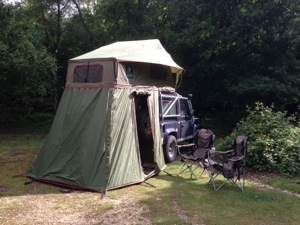 With the weather forecast looking pretty bad for the rest of our planned trip, this morning we had to make a decision. After much discussion we decided that we’d need to follow the weather and abandon the planned route. Rather than complete our tour of the south west coast where wind gusts are forecast to be around 65-70 we have diverted to the new forest for a couple of days to see what the weather actually does.
With the weather forecast looking pretty bad for the rest of our planned trip, this morning we had to make a decision. After much discussion we decided that we’d need to follow the weather and abandon the planned route. Rather than complete our tour of the south west coast where wind gusts are forecast to be around 65-70 we have diverted to the new forest for a couple of days to see what the weather actually does.
The good news was that, on arriving after a 4 hour drive, there was very little wind and the sun was shining !
We’ve not managed to test out a lot of the things we wanted to test on this trip but one thing we have learned is to adapt rather than stick to a plan.
So we’re now in the New Forest for a couple of nights, two pubs within easy walking distance and a nice secluded and sheltered location should the winds start to pick up as they are forecast to.
Little Big Adventure
 Another “trial run” is under way, this time a slightly longer trip with a different camp site every night and varied roads and distances between them.
Another “trial run” is under way, this time a slightly longer trip with a different camp site every night and varied roads and distances between them.
The first night was a pleasant enough stay in the Cotswolds with reasonable weather albeit with a smattering of rain overnight.
The second night was more of a “trial” than anticipated. During the late evening the winds got up and we paid the penalty for being in a high tent on what was essentially an open hillside overlooking the sea. The tent itself weathered the onslaught well without any problems at all really, the occupants on the other hand got very little sleep. The combination of noise from the wind and the Land Rover seeming to want to roll over as each new, more powerful gust hit it, made it nearly impossible to sleep. It didn’t help that we’d pitched it side on to the most powerful gusts of wind.
In the end we called it a day not long after dawn, deciding trying to sleep was a pointless exercise and we’d be better off getting up and packing the tent away and moving on.
More gales are forecast for the rest of the week so we’re looking for more sheltered sites and taking care to try and park up with the Land Rover facing into the wind.
Packing it all in…
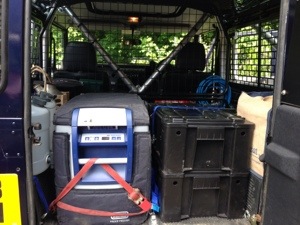 Spent a good part of today packing, unpacking and repacking the 90 in preparation for our latest mini expedition. This will probably be the last real shakedown before we ship to Australia so lots to learn and test !
Spent a good part of today packing, unpacking and repacking the 90 in preparation for our latest mini expedition. This will probably be the last real shakedown before we ship to Australia so lots to learn and test !
We eventually managed to get everything we need in and still have some space to spare… It is starting to get a bit crowded in there though. In the next couple of weeks we should finalise the list of what’s worth taking and what can be left behind and hopefully we’ll also get an idea of the fuel consumption we can expect when fully loaded.
Rear recovery point
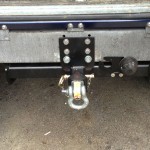 For a while now I’ve planned to replace the standard drop plate and tow hitch on the back of the 90 with a 2 inch receiver. This allows a number of different items to be attached to the rear of the vehicle including a standard drop plate for towing or a simple shackle for recovery. If we can figure out somewhere to store it we’ll get a winch mounting plate for it too so we can potentially move the winch from the front to the rear.
For a while now I’ve planned to replace the standard drop plate and tow hitch on the back of the 90 with a 2 inch receiver. This allows a number of different items to be attached to the rear of the vehicle including a standard drop plate for towing or a simple shackle for recovery. If we can figure out somewhere to store it we’ll get a winch mounting plate for it too so we can potentially move the winch from the front to the rear.
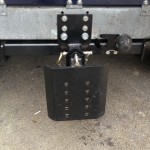 I’ve been putting the job off because the standard hitch was bolted on before the rear fuel tank was fitted without using captive nuts. The upshot of which is that it looked like I’d need to drop the rear fuel tank to change it which is far from an easy job on a TD5 90 let alone one with an additional tank connected to it.
I’ve been putting the job off because the standard hitch was bolted on before the rear fuel tank was fitted without using captive nuts. The upshot of which is that it looked like I’d need to drop the rear fuel tank to change it which is far from an easy job on a TD5 90 let alone one with an additional tank connected to it.
Anyway, as it turned out I managed to do the job with a bit of keyhole surgery, managing to slide the tank and it’s guard half an inch forward, just enough to get the job done. I made up a 6mm thick spreader plate and welded captive nuts on it to fit the receiver hitch so I shouldn’t have the problem again.
Remote Comms Sorted
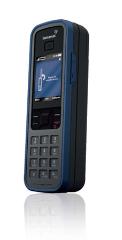 Another “major” piece of kit has been acquired now and ticked off the list. We’ve decided to go with a satellite phone for emergency use rather than a radio set although we’ll have the VHF set for “local” communications.
Another “major” piece of kit has been acquired now and ticked off the list. We’ve decided to go with a satellite phone for emergency use rather than a radio set although we’ll have the VHF set for “local” communications.
To save some of the budget we went for a second hand one so have been keeping an eye on eBay for the right combination of price and condition. The one we eventually bought came complete with a waterproof Peli case and 60 units prepaid so we can experiment with it and get familiar with it’s features without worrying about the cost.
We went for an Inmarsat Isatphone Pro which seems to be well regarded and certainly initial impressions suggest it’s a well put together piece of kit. It has a whole load of features and options but I guess the most important for our use apart from voice communications is the ability to quickly email or SMS our exact location.
Brakes sorted
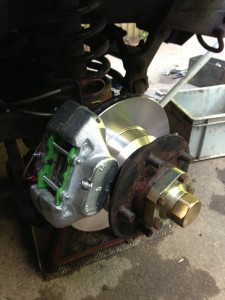 This weekend was a chance to catch up on some maintenance and servicing jobs. My competition Land Rover ate it’s front prop shaft while pulling the caravan back from the bank holiday trials weekend so Saturday was devoted to some well overdue TLC for that given the 90 has been taking most of my spare time up.
This weekend was a chance to catch up on some maintenance and servicing jobs. My competition Land Rover ate it’s front prop shaft while pulling the caravan back from the bank holiday trials weekend so Saturday was devoted to some well overdue TLC for that given the 90 has been taking most of my spare time up.
With the competition motor back up to spec I set about servicing the brakes on the 90. The front brakes are the vented type from a Range Rover and the callipers are the best part of 20 years old. I rebuilt them nearly 10 years ago with new pistons and seals but they are probably one of the oldest components of the vehicle so well overdue for replacement.
Today was spent replacing the two front callipers along with one of the brake lines that looked a bit borderline. Along with the callipers I changed the rotors/disks too so with a new set of brake pads it should give a bit more bite under braking. I’ll swap the rear disks out too at some point as there’s no point in starting the trip with components that aren’t 100%.

